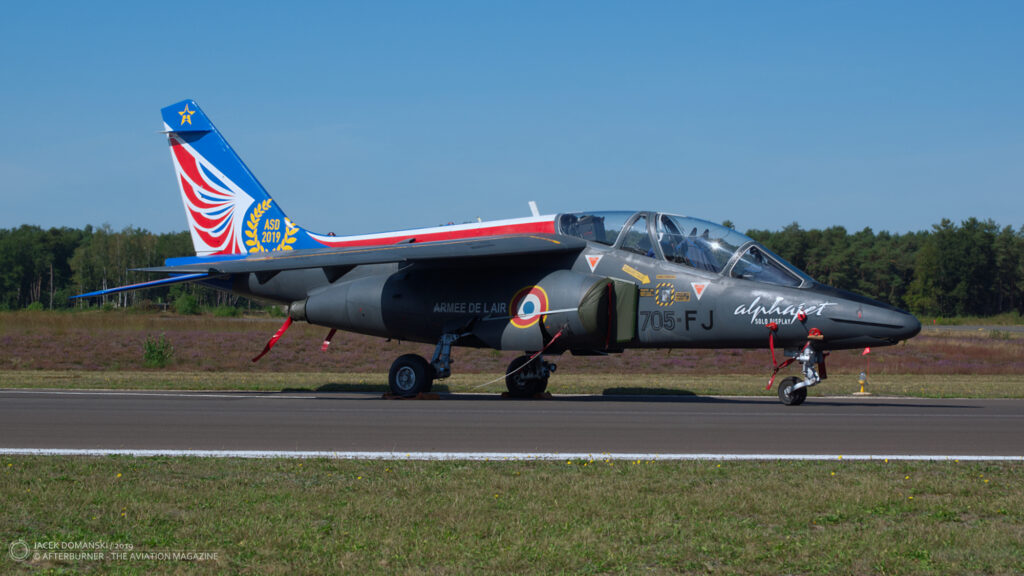 Dassault / Dornier Alpha Jet E (c/n E33, 705-FJ of the French Air Force / Armée de l’Air), static display at Kleine-Brogel air base spotter day, September 2019.
Dassault / Dornier Alpha Jet E (c/n E33, 705-FJ of the French Air Force / Armée de l’Air), static display at Kleine-Brogel air base spotter day, September 2019.
In the early 1960s, European NATO countries were considering replacement of the first-generation jet trainig aircraft – such as French-manufactured Magister or British-made Folland Gnat T1 – with new design, following the development of combat jet-powered aeroplanes.
This time, to create the new trainer, the French aviation industry was seeking for an international partner and the United Kingdom was the first choice. In 1965, Memorandum of Understanding was signed between those countries, focused on development of advanced supersonic trainer. The programme included all leading aviation companies from both France and the UK, such as BAC, Hunting, Hawker Siddeley, Folland, Breguet, Potez, Sud-Aviation, Nord and Dassault. The aircraft had to meet the requirements defined in locally issued specifications – Air Staff Target 362 in the UK and École de Combat et d’Appui Tactique (ECAT – Tactical Combat Support Trainer) in France.
In 1966, a joint venture company named SEPECAT (Société Européenne de Production de l’Avion d’École de Combat et d’Appui Tactique – European company to produce a combat trainer and tactical support aircraft) was established. Two years later, a prototype of new aeroplane performed its maiden flight. Regrettably, the outcome of that bi-national cooperation was far away from the requirements for a light training aircraft. The aircraft, later known as Jaguar, was significantly bigger, nuclear-capable fighter-bomber, based on the AFVG (Anglo-French Variable Geometry) specification.
As a consequence, France began to look for another partner to re-launch the jet trainer programme and that time focused on the German aviation industry. At that time, the Luftwaffe pilots were trained in the United States, using the American-made aircraft. Therefore, it seemed logical for Germany to move those activities to Europe and to switch for domestically made aeroplane. Regrettably for the Luftwaffe, that idea triggered a strong negative reaction in the US and was eventually abandoned in 1971.
Nevertheless, there was another aeroplane operated by the German Air Force that needed a replacement. It was Fiat G.91 attack aircraft, introduced into service in 1958. Eventually, the Germany agreed to develop the new jet in cooperation with France, however it had to be split into a trainer variant for the French Air Force and close air support (CAS) version for the Luftwaffe.
A few concepts of the new aircraft were submitted by Dassault, Breguet, Dornier, VFW-Fokker and MBB companies. In July of 1970, the Breguet-Dassault- Dornier joint venture was announced the winner of the competition, with their project designated TA501.
In February of the next year, works on four prototypes of the trainer began. Two of them were made at Dassault plant in France and another two at Dornier factory in Germany. They have performed their maiden flights on 26th October 1973 and 9th January 1974, respectively. Following the abovementioned split of the aircraft roles, the second French-made prototype was built as the trainer, while the second German one was made in the CAS configuration.
Shortly after its first flight, the aircraft was approved for serial manufacturing. The production process was split between Dassault, Dornier and, in addition, SABCA aviation plant in Belgium. Each of the companies was able to perform final assembly of the aircraft, officially designated Alpha Jet A for attack version and Alpha Jet E for trainer.
The first production aircraft was ready in November of 1977, but official deliveries began almost a year later. The German- and French-made aeroplanes had different avionics and could be easily recognized by their nose – sharp-pointed in the German variant and rounded in the French one.
Germany, France and Belgium became the first customers of the new aircraft but in 1978, a license agreement was signed to produce the Alpha Jet in Egypt. The aeroplanes made there were the trainers, designated as MS1.
Although hopes for international sale of the Alpha Jet were high, the Franco-German aircraft had to compete with other aeroplanes of similar role and capabilities, first and foremost with the British-developed BAE Hawk. Consequently, France and Germany remained the main operator of the Alpha Jet, each of them with a fleet of approximately one hundred seventy aircraft. Among other customers there were Cameroon, Morocco, Nigeria, Qatar, Togo and Côte d’Ivoire – thus mainly the countries being a former French colony or having a long-term commercial relationship with the French military industry.
Germany decided to retire the Alpha Jets in the early 1990s. Many aircraft were offered for sale and were acquired by Portuguese Air Force, as well as several civilian operators (providing their services for air force training purposes), such as Air Affairs, Top Aces or QinetiQ.
During their service, the Alpha Jet aircraft were the subject of several upgrades and modifications. The most important ones were designated Alpha Jet 2 (conversion of the E variant for the CAS role, French official name Nouvelle Generation Appui/École – New Generation Attack/Training), MS2 (capable to use air-to-air missiles, with new avionics, glass cockpit and modified engines) and ATS (Advanced Training System, also known as the Alpha Jet 3, featuring the glass cockpit and modern avionics).
Nowadays, the French Air Force is still operating approximately one hundred of the Alpha Jet trainers. They are also used for aviation display purposes, being flown by the world-famous French official jet aerobatic team Patrouille de France, as well by Alpha Jet Solo Display.
Back in September of 2019, the aircraft of the Alpha Jet Solo Display participated in Sanicole International Airshow and Kleine-Brogel spotter day. And it was exactly the latter event where our current Photo of the Week was taken.



